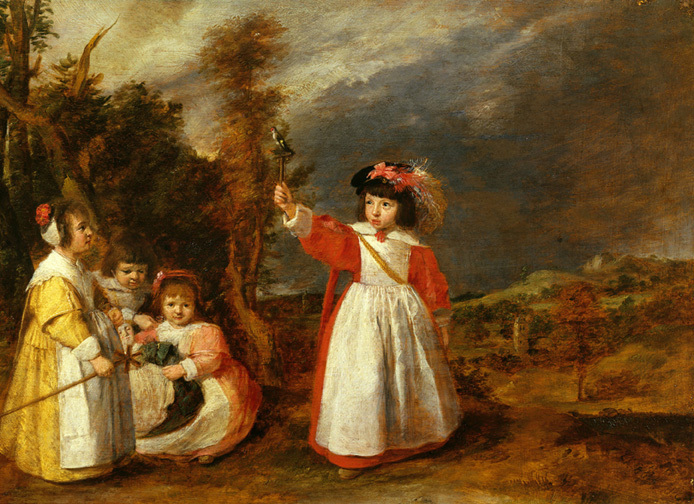Traditional Representations of Children in Art
Where to start?
Philippe Airès argues that the idea of childhood emerged in the Renaissance (qtd. in Averett 3). Indeed, looking at images spanning nearly four centuries highlights shifting constructions of children. I have decided to start in the fifteenth century, near the end of the medieval period. The artist, Mateo Felice, was a renowned medieval artist from Naples.
In the image, David with Musicians and Dancing Children, the children’s facial features are remarkably similar to the adults’. While the children are slightly smaller in stature than the adults, their size constructs them as “mini adults” rather than “children.” In the painting, the children enhance David’s prominence and importance.
The following painting, titled Anne, Lady Pope with Her Children by Marcus Gheeraerts the Younger depicts Anne Hopton, Lady Pope (1561-1625), Wife of Henry, 3rd Baron Wentworth and later of Sir William Pope of Wroxton, later 1st Earl of Downe, with her three children, Thomas, Henry and Jane, from her first marriage to Henry, 3rd Baron of Wentworth. This painting was composed over one hundred years after Mateo’s Felice’s David with Musicians and Dancing Children, but bears some similarities in regards to the construction of the subjects.
Thomas (left), Henry (middle), and Jane (right) all have similar expressions to their mother, Anne. However, I would suggest that this photo shows a demarcation from the Medieval Period because of their softened countenances.
Nonetheless, all three children remain dressed in adult-like clothing. The way that Jane is dressed is particularly striking. Her clothing is heightened by the fact that she is depicted in a similar pose to that of her mother. Thus although Airès suggests that notions of childhood ended in the Medieval period, Gheeraerts' 1596 portrait by illustrates that childhood is still closely tied to adulthood during the early modern period.
Young Children Playing a Game by Adriaen Brouwer and Joos van Craesbeeck (below) was published in the early 17th century, around the time that the 1610 edition of Foxe’s Acts and Monuments was released. What is striking about this oil painting are the subjects: while previous centuries had seen children being depicted alongside their parents or authorial figures, Brouwer and Craesbeeck’s work centers upon the children.
The painting of the three young children playing is conducive to a broader ideological shift towards preserving childhood innocence. Indeed, Averett argues that during the Renaissance, the notion of “childhood” began to take shape and the transformation was largely complete by the seventeenth century (4). Children are now shown as individuals, with childlike features, holding children’s objects, and engaged in children-specific behaviours (4). Thus in Brouwer and Craespeeck’s image the children are shown playing, breaking with a tradition of children being seen as performing “labor activities or other social roles” (qtd. in 4).
It is true that in Young Children Playing a Game nearly all of the young people are shown holding children-specific objects and toys. While it is ambiguous as to the function of the objects, the title of the painting suggests that they are enjoying their time playing a game as a group.
Moreover, the child in the center of the image is full of implied movement. While the portrait of Anne, Lady Pope and her children from the previous century depicted stiff body posture, Brouwer and Craespeeck’s construction captures a certain joie de vivre.
Interestingly, their body movements are closer to Mateo Felice’s David with Musicians and Dancing Children from the Late Medieval Period. However, their features are softened and are more childlike than Felice’s painting.
Most startling, however, is the absence of adults. While the children are still dressed in adult-like garments, authorial figures are nowhere to be found. Children, it seems, now occupy their own sphere.
Finally, we turn to Daniel Chodowieki’s 1787 painting of three children playing. Again, the children are the central subjects within the photo: no adults are present. Furthermore, there is a range of clothing choices for the children. Rather than having children dressed as mini-adults, the gowns in the image correlate to their respective ages. Indeed, the youngest girl is dressed simply in a white tunic, while the dresses of the other two girls are more intricate.
Looking at how the girls’ hair is styled, as well, permits insight into how childhood is being constructed. Rather than being bound in plaits, all three have freefalling curls.
I provide this overview to allow for a more nuanced understanding of the children in Foxe’s Acts and Monuments. Children, such as Conrad II, draw on both Medieval and early modern understandings of childhood.




